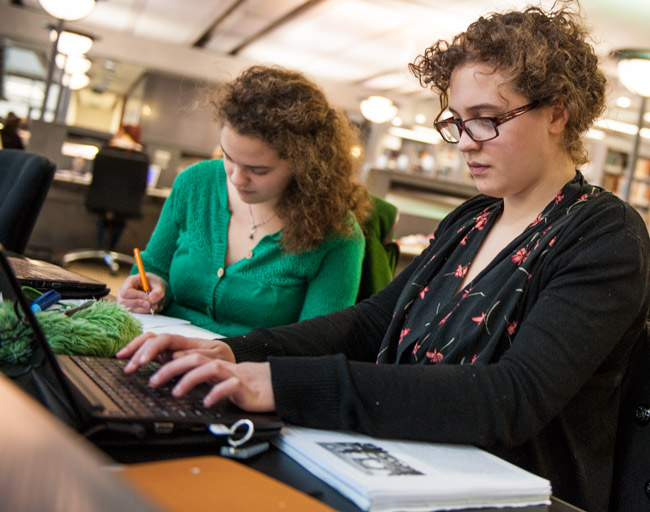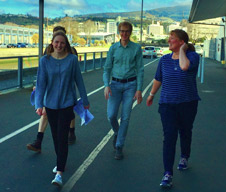
Do you spend most of your day at your desk? Otago researchers need you for a new study.
Otago researchers are seeking staff members and PhD students who spend most of their day sitting at their desk for a new study into patterns of physical activity and sedentary behaviour in people working in sedentary occupations.
The study's lead researcher, Master of Dietetics student Millie Keown, says advancing technologies over the past 70 years mean people spend a lot more time sitting – particularly in the workplace. Prolonged sitting increases the risk of heart disease and diabetes.
But the news is not all bad. Recent research from Otago's Department of Human Nutrition has shown that regularly interrupting prolonged sitting with two-minute bouts of activity every 20 to 30 minutes might reverse the harm of prolonged sitting by lowering blood glucose and lipid levels in the bloodstream after a meal.

Lead researcher Master of Dietetics student Millie Keown (left) takes part in a "walking meeting" with her supervisors Professor Murray Skeaff and Dr Meredith Peddie. Fellow student Matt Reeves is obscured.
“Naturally, we wanted to know if people would perform short bouts of regular activity throughout their work day,” she says.
Ms Keown says a pilot study, involving a small number of participants found participants were already taking, on average, 12 two-minute breaks each day – far more than anticipated.
“Therefore, the purpose of my research is to more thoroughly investigate the patterns of physical activity and sedentary behaviour in people who work in jobs conventionally seen as 'sedentary' at University of Otago.”
Participants must be between 18 to 65 years old, speak English, be employed 0.75 EFTs or more, and spend at least three quarters of their work day sitting down.
“This study will give us accurate information about much time 'sedentary' workers spend in prolonged sitting in both work and non-work hours each day. We also hope to find out the number of breaks taken from prolonged sitting each day, and the average intensity and duration of these breaks. Additionally, we will find out the time participants spend in being physically active each day.”
Those who sign up to the study will wear two different motion-sensing detectors – one which is considered to be the gold standard at measuring physical activity, and another which is considered to be the gold standard at differentiating sitting from standing.
Ms Keown says her team has recruited about 45 people so far, but is aiming for 200 participants – so any expressions of interest would be welcomed.
The results will be used for interventional studies – which would encourage office workers to take more activity breaks, without compromising their work.
As a thank you for participating, all participants will receive a personal summary of their levels of physical activity and sedentary behaviour.
Want to sign up?
Contact Millie Keown, Email: activitybreaks-study@otago.ac.nz